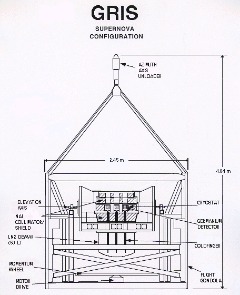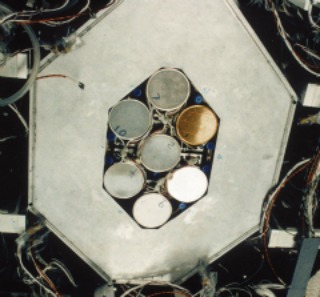Balloon-borne experiment: The balloon and GRIS payload head up to a float altitude of approximately 40 km. At float, the 39-million cubic foot balloon will expand to about the size of a football field.
Credit: NASA/GSFC
When I first began working here at Goddard, we were developing instruments to detect gamma rays and flying them on high-altitude balloons. It’s an adventure flying a payload on a balloon! There are two times a year when the wind reverses direction and the balloon temporarily stops at high altitudes. You have to launch when you know your balloon will pretty much stay overhead for a day or two at about 40 kilometers (25 miles) high. You prepare your instrument and wait until the wind is right so your balloon won’t drift a lot in longitude or latitude as it rises. You fill up this gigantic balloon with helium, let it go, and it lifts up your payload. When the flight is over, you cut the payload loose from the balloon and it is lowered to the ground with a parachute. Then you try to find it somewhere, like in a farmer’s field.
We had an instrument called the Gamma-Ray Imaging Spectrometer (GRIS), which was a balloon-based instrument capable of high resolution gamma-ray spectroscopy. The instrument had seven of these detectors in a big shield, and they were mounted on a gondola the size of a table. All of this would go up on the balloon. There was also a pointing system – a way of aiming and steadying a telescope – just like there is on a telescope on a mountain, or in space.
The solid-state detectors we used then were made from solid germanium crystals, which are dense and good at stopping gamma rays. We had to keep the germanium cold using liquid nitrogen. When germanium gets cold, its background noise from thermal fluctuations goes down and it can be used for detecting gamma rays. We were developing this new technology along with groups at Bell Labs and the NASA Jet Propulsion Laboratory.
GRIS instrument schematic: Diagram illustrating the placement of the detectors and shields.
Credit: NASA/GSFC
GRIS germanium detectors: GRIS consists of seven of the world's largest, high-purity, n-type germanium (Ge) detectors. The detectors are cooled to liquid nitrogen temperatures (in order to achieve high resolution) and are surrounded by a thick anti-coincidence shield which allows the rejection of background events from true astrophysical events.
Credit: NASA/GSFC; Image courtesy Neil Gehrels




